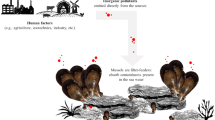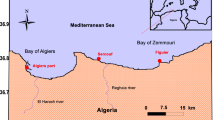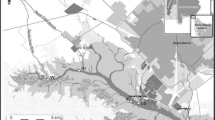Abstract
Concentrations of zinc and cadmium in whole soft parts of mussels, Mytilus edulis (L.), collected from 54 locations in Scandinavian waters were determined. Local variations in concentrations of the two metals found in samples taken close to industrial sources of zinc and cadmium confirmed the ability of the mussel to act as an accurate indicator of pollution by these metals over the entire range of salinities in which this species can exist. In addition, offshore samples remote from industrial discharges revealed higher concentrations of zinc and cadmium in mussels from lowsalinity areas (Gulf of Finland, Southern Bothnian Sea, Baltic proper) than in those from high-salinity areas (Kattegat, Eastern Skagerrak). Major decreases in metal concentrations present in the mussel were apparent in the regions of the Sound and the Great Belt, which are areas of rapid salinity change due to mixing of Baltic water with water from Kattegat. Comparison of these results with those reported for zinc and cadmium in water throughout the study area suggested the existence of a higher biological availability of these metals in regions of low salinity; possible reasons for this are discussed. Data from the present survey are also compared to those reported for mussels taken elsewhere. This comparison reveals the Baltic area to be considerably polluted by trace metals; in contrast, the waters of Kattegat and skagerrak are considered to be relatively unpolluted.
Similar content being viewed by others
Literature Cited
Abdullah, M. I. and L. G. Royle: A study of the dissolved and particulate trace elements in the Bristol Channel. J. mar. biol. Ass. U.K. 54, 581–597 (1974)
Boyden, C.R.: Distribution of some trace metals in Poole Harbour, Dorset. Mar. Pollut. Bull. 6 (12), 180–187 (1975)
Brooks, R.R. and M.G. Rumsby: The biogeochemistry of trace element uptake by some New Zealand bivalves. Limnol. Oceanogr. 10, 521–528 (1965)
Cunnigham, P.A. and M.R. Tripp: Factors affecting the accumulation and removal of mercury from tissues of the American osyster Crassostrea virginica. Mar. Biol. 31, 311–319 (1975)
Edgren, M.: Recipientundersökningar rörande lokalisering av kraftverk till Nynäshamn. Report in Swedish from Statens Naturvårdsverk Undersökningslaboratoriet, Radioekologiska sektionen, 9 November 1973. (Copies available from the secretary, Statens Naturvårdsverk, Undersökningslaboratoriet, 170 11 Drottningholm Stockholm, Sweden)
Metaller och närsalter i sediment och vattenburen partikulär substans. Report in Swedish from Statens Naturvårdsverk Undersökningslaboratoriet, 25 November 1976. (Copies available from the Secretary, Statens Naturvärdverk, Undersökningslaboratoriet, 170 11 Drottningholm, Stockholm, Sweden)
Eustace, I.J.: Zinc, cadmium, copper and manganese in species of finfish and shellfish caught in the Derwent Estuary, Tasmania. Aust. J. mar. Freshwat. Res. 25, 209–220 (1974)
Fulkerson, W., H.E. Goeller, J.S. Gailar and E.D. Copenhaver (Eds.): Cadmium, the dissipated element. Oak Ridge, Tennessee: Oak Ridge National Laboratory (Ref. ORNL NSF-EP-21) 1973
Goldberg, E.D.: The mussel watch — a first step in global marine monitoring. Mar. Pollut. Bull. 6 (6), p. 111 (1975)
Gustavsson, I.: The concentration of heavy metals in the receiving waters off the nuclear power plants of Sweden. The National Swedish Environment Protection Board, Research Laboratory for Coastal Research (Ref. SNV PM 785E) 1976. (Copies available from the Secretary, Statens Naturvårdverk, Undersökningslaboratoriet, 170 11 Drottningholm, Stockholm, Sweden)
Hutchins, L.W.: The bases for temperature zonation in geographical distribution. Ecol. Monogr. 17, 325–335 (1947)
Ireland, M.P.: Result of fluvial zinc pollution on the zinc content of littoral and sublittoral organisms in Cardigan Bay, Wales. Envir. Pollut. 4, 27–35 (1973)
Kinne, O.: Salinity: animals — invertebrates. In: Marine ecology, Vol. 1. Part 2. pp 821–995. Ed. by O. Kinne. London: Wiley-Interscience 1971
Leatherland, T.M. and J.D. Burton: The occurrence of some trace metals in coastal organisms with particular reference to the Solent region. J. mar. biol. Ass. U.K. 54, 457–468 (1974)
Nullin, J.B. and J.P. Riley: The occurrence of cadmium in sea water and in marine organisms and sediments. J. mar. Res. 15, 103–122 (1956)
Myers, V.B., R.L. Iverson and R.C. Harriss: The effect of salinity and dissolved organic matter on surface charge characteristics of some euryhaline phytoplankton. J. exp. mar. Biol. Ecol. 17, 59–68 (1975)
Nickless, G., R. Stenner and N. Terrille: Distribution of cadmium, lead and zinc in the Bristol Channel. Mar. Pollut. Bull. 3 (12), 188–190 (1972)
Nielsen, S.A. and A. Nathan: Heavy metal levels in New Zealand molluscs. N.Z. Jl mar. Freshwat. Res. 9, 467–481 (1975)
O'Hara, J.: Cadmium uptake by fiddler crabs exposed to temperature and salinity stress. J. Fish. Res. Bd Can. 30, 846–848 (1973)
Dentreath, R.J.: The accumulation from water of Zn65, Mn54, Co58 and Fe59 by the mussel, Mytilus edulis. J. mar. biol. Ass. U.K. 53, 127–143 (1973)
Phillips, D.J.H.: The common mussel Mytilus edulis as an indicator of pollution by zinc, cadmium, lead and copper. I. Effects of environmental variables on uptake of metals. Mar. Biol. 38, 59–69 (1976a)
— The common mussel Mytilus edulis as an indicator of pollution by zinc, cadmium, lead and copper. II. Relationship of metals in the mussel to those discharged by industry. mar. Biol. 38, 71–80 (1976b)
— Effects of salinity on the net uptake of zinc by the common mussel Mytilus edulis. Mar. Biol. 41, 79–88 (1977a)
— The use of biological indicator organisms to monitor trace metal pollution in marine and estuarine environments — a review. Envir. Pollut. 13, 281–317 (1977b)
Preston, A., D.F. Jefferies, J.W.R. Dutton, B.R. Harvey and A.K. Steele: British Isles coastal waters: the concentrations of selected heavy metals in sea water, suspended matter and biological indicators: a pilot survey. Envir. Pollut. 3, 69–82 (1972)
Preston, E.M.: The importance of ingestion in chromium-51 accumulation by Crassostrea virginica (Gmelin). J. exp. mar. Biol. Ecol. 6, 47–54 (1971)
Schroeder, H.A., A.P. Nason, I.H. Tipton and J.J. Balassa: Essential trace elements in man: zinc. Relation to environmental cadmium. J. chron. Dis. 20, 179–198 (1967)
Schulz-Baldes, M.: Die Miesmuschel Mytilus edulis als Indikator für die Bleikonzentration im Weserästuar und in der Deutschen Bucht. Mar. Biol. 21, 98–102 (1973)
—: Lead uptake from seawater and food, and lead loss in the common mussel Mytilus edulis. Mar. Biol. 25, 177–193 (1974)
Segar, D.A., J.D. Collins and J.P. Riley: The distributions of the major and some minor elements in marine animals. II. Molluscs. J. mar. biol. Ass. U.K. 51, 131–136 (1971)
Segerstråle, S.G.: The Tvärminne excursion. A confrontation with the brackish Baltic. Limnologorum Conventus 13, 46–72 (1956)
—: Baltic Sea. Mem. geol. Soc. Am. 67, 751–800 (1957)
Sen Gupta, R.: On some trace metals in the Baltic. Ambio 1, 226–230 (1972)
Stenner, R.D. and G. Nickless: Distribution of some heavy metals in organisms in Hardangerfjord and Skjerstadfjord, Norway. Wat. Air Soil Pollut. 3, 279–291 (1974)
——: Heavy metals in organisms of the Atlantic coast of South-West Spain and Portugal. Mar. Pollut. Bull. 6 (6), 89–92 (1975)
Styron, C.E., T.M. Hagan, D.R. Campbell, J. Harvin, N.K. Whittenburg, G.A. Baughman, M.E. Bransford, W.H. Saunders, D.C. Williams, C. Woodle, N.K. Dixon and C.R. McNeill: Effects of temperature and salinity on growth and uptake of Zn65 and Cs137 for six marine algae. J. mar. biol. Ass. U. K. 56, 13–20 (1976)
Svansson, A.: The water exchange of the Baltic. First Swedish Symposium on the pollution of the Baltic: Stockholm, September 8–10 1971. Ambio spec. Rep. 1, 15–19 (1972)
Talbot, V., R.J. Magee and M. Hussain: Cadmium in Port Phillip Bay mussels. Mar. Pollut. Bull. 7 (5), 84–86 (1976)
Author information
Authors and Affiliations
Additional information
Communicated by T.M. Fenchel, Aarhus
Rights and permissions
About this article
Cite this article
Phillips, D.J.H. The common mussel Mytilus edulis as an indicator of trace metals in Scandinavian waters. I. Zinc and cadmium. Mar. Biol. 43, 283–291 (1977). https://doi.org/10.1007/BF00396922
Accepted:
Issue Date:
DOI: https://doi.org/10.1007/BF00396922




